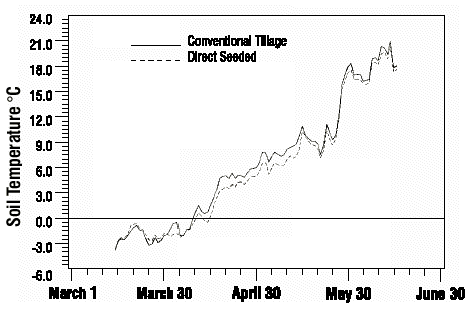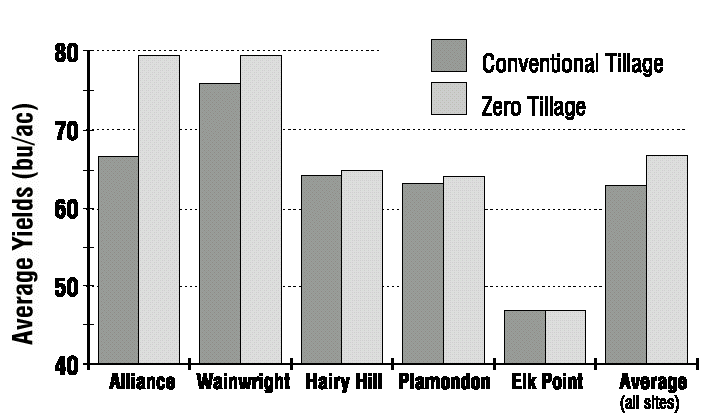| | Factors affecting spring soil temperatures | Soil temperature and crop growth | Establishing a healthy crop stand
Spring soil temperatures are often cooler under direct seeding than conventional tillage. However, research shows this does not usually affect crop yields if good direct seeding practices are followed.
Factors Affecting Spring Soil Temperatures
Research studies comparing seedbed soil temperatures in direct seeding and conventional tillage systems show a slight advantage to tillage during the spring warming period (Figure 1). Conventionally tilled soils in the Black soil zone average about 1°C warmer at the 5 cm depth, but can be as much as 3°C warmer for a brief periods during some springs. The advantage usually lasts until mid or late June, when the crop canopy has fully established.

Figure 1. Average daily spring soil temperature at 5 cm depth, 1995 to 1998, at Fort Saskatchewan
The cooler soils under direct seeding are mainly due to the crop residue layer on the soil surface. Data from the Alberta Reduced Tillage Initiative Demonstration Farm at Red Deer show that thicker residue layers result in cooler soils during the spring. Crop residue reflects sunlight and insulates the soil from the air. Thicker layers provide better insulation. While this protects direct seeded soils from extreme seasonal temperature changes, it also slows spring warming.
During daytime heating, direct seeded soils tend to not warm as much as conventionally tilled soils, but daily minimum temperatures are similar. This suggests that much of the additional heat gained each day in tilled soils is lost at night. Some evidence suggests that this heat loss may warm the seedlings, making overnight cooling and frost risk less severe in tilled soils than in direct seeded soils.
Moist soils warm more slowly than dry soils, and direct seeded soils are usually moister than conventionally tilled soils, especially at the surface. The increased moisture is a result of the residue layer that reduces evaporation from the soil. As well, the standing stubble contributes to higher soil moisture by trapping snow and reducing wind speed for reduced evaporation.
In the spring, the soil is warmest near the surface, which is very important for direct seeding. Table 1 shows that much of the heat advantage tillage has when seeding at 5 cm depth can be offset by seeding shallower when direct seeding. The higher near-surface soil moisture levels under direct seeding are critical for making shallow seeding viable. Further research is needed to determine optimum levels of residue for direct seeded soils.
Table 1. Spring temperature differences between conventionally tilled and direct seeded soils
Period | Average Difference*
at 5 cm depth | Average Difference*
conventional tillage at 5 cm depth
direct seeded at 2 cm depth |
| March 15 - 31 | -0.29 | -0.27 |
| April 1 - May 10 | 0.89 | 0.27 |
| May 11 - June 15 | 0.78 | 0.46 |
* Average Difference is the average of (temperature of conventionally tilled soil in °C - temperature of direct seeded soil in °C)
As well, slope characteristics, organic matter content and soil texture affect soil temperature. South-facing slopes receive more energy from the sun and so tend to warm faster than level areas which in turn warm faster than north-facing slopes. Soils higher up on slopes are usually drier than soils in lower areas, and therefore usually warm faster. Similarly, sandy soils and soils low in organic matter tend to hold less moisture and so may warm faster than clay soils and soils higher in organic matter.
Soil Temperature and Crop Growth
Seed of most major crops grown in Alberta (cereals, Argentine canola, pulses) begins to germinate at temperatures as low as 3 to 5°C. Polish canola is the exception; it starts to germinate at about 5°C but usually requires a seed bed of about 7 to 10°C for a healthy stand.
Germination and seedling growth are variable and slow at low soil temperatures. As temperature increases, germination and emergence become faster and more uniform. Generally, the time to emergence halves for every 5°C increase between 5 and 20°C. Percent emergence is also usually higher on warmer soils.
Plot data from Fort Saskatchewan have shown that crop emergence and early growth under direct seeding are delayed during the first three weeks following seeding, after which the differences begin to disappear. There have also been some field observations of slightly higher spring frost damage in direct seeded fields than in conventionally tilled fields under comparable conditions.
Crop maturity may also be delayed depending on summer growing season conditions. Although yields may be lower in some years, research shows that on average, over the long term, direct seeding yields are as high or higher than conventional tillage yields under most conditions. Delayed emergence and maturity are a greater concern in areas with a very short growing season. In this study, improved yields under zero tillage were attributed to increased soil moisture in drier years.

Figure 2. Effect of zero and conventional tillage on barley yields, 1988 to 1992, at five sites in northeastern Alberta
Establishing a Healthy Crop Stand
Along with soil temperature, several other factors influence crop growth such as seeding depth, packing, fertilizer placement, residual herbicide, crop residue management, disease and seed quality. For healthy crop stands under direct seeding, follow these tips:
- Ensure an even spread of chaff and chopped straw so seeding equipment will not plug in areas with heavy crop residues, soil will warm more evenly, and hairpinning will be reduced. (See also: Equipment Issues in Crop Residue Management for Direct Seeding Agdex 519-4 and Residue Management for Successful Direct Seeding, Agdex 570-4).
- Seed as shallow as possible (large-seed crops require deeper seeding than small-seed crops). Direct seeding can usually occur at a shallower depth than conventional seeding because of better soil moisture conditions near the surface. Also, at shallower depths, spring soil temperatures are warmer.
- In areas with a short growing season, consider using openers that push crop residue away from the seed furrow. Crop residue left on the seed row reflects sunlight, slowing seed bed warming. Most hoe and knife openers push the residue off the furrow, allowing the soil to warm faster.
- Pack soil to ensure good seed-to-soil contact, but do not overpack wet clay soils.
- Use safe rates of seed-placed fertilizer; consider equipment that separates the seed and fertilizer. (See Alberta Fertilizer Guide, Agdex 541-1, and Ground Opener Systems, Agdex 519-24, for more information.)
- Ensure herbicide residues will not affect the crop being seeded.
- Use plump seed with high germination and seedling vigour.
- Rotate crops, and treat the seed to minimize disease concerns.
Conclusion
Research has shown that soil temperature, while cooler under direct seeded soils, does not appear to be a concern in most years. Cooler seedbeds can be managed through even spreading of crop residues and shallower seeding.
Prepared by Ben Froebel and Allan Howard , Alberta Agriculture, Food and Rural Development.
Source: Agdex 590-2. Revised May 1999. |
|